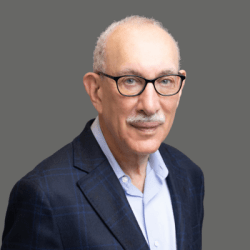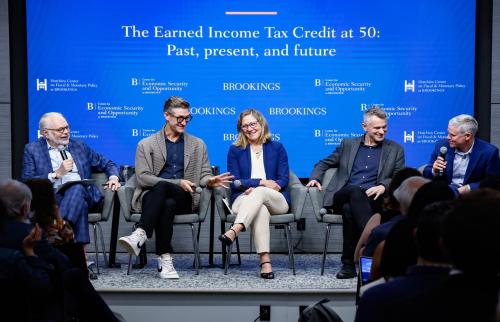The U.S. safety net has grown significantly stronger for children and elderly adults over the past half century. However, the story is starkly different for non-elderly adults who are not raising children and do not receive Supplemental Security Income disability benefits or Social Security benefits, Robert Greenstein argues in his Hamilton Project paper. In 2017, this group numbered nearly 106 million people, or nearly 33 percent of the U.S. noninstitutionalized population.
How the safety net affects poverty among non-elderly childless adults who do not receive disability benefits
Using Census data analyzed by Danilo Trisi (and the Supplemental Poverty Measure), Greenstein shows that, in 2017, while the safety net lifted out of poverty 69 percent of elderly adults who would otherwise be poor and 44 percent of otherwise-poor children, it lifted from poverty only 8 percent of otherwise-poor non-elderly childless adults who were not receiving disability benefits.
Further, with the safety net for these non-elderly childless adults as limited as it is, the non-elderly childless adults who are poor tend to be poorer than others living in poverty. One of every two Americans living in “deep poverty,” with incomes below half of the poverty line, is a childless adult not receiving disability benefits. And childless adults with low earnings are the only group in America that the federal tax code taxes into, or deeper into, poverty.
Over the past five decades, the antipoverty impact of government programs strengthened substantially for some groups—but not for non-elderly childless adults not receiving disability benefits. In 2017, the safety net shrank the poverty gap among poor elderly adults by 86 percent, up from 67 percent in 1970. (The poverty gap is the total amount by which the incomes of all those who are poor fall below the poverty line.) For children, the safety net shrank the poverty gap by 67 percent in 2017, up from 31 percent in 1970. But among non-elderly childless adults not receiving disability benefits, it shrank the poverty gap by only 23 percent in 2017—which was a decrease from 28 percent in 1970.
Greenstein also points out the grim picture for childless adults in homelessness data. Households consisting solely of adults comprised 71 percent of those who were homeless in 2023. At least 91 percent of those adults were between the ages of 18 and 64. Moreover, lower-income non-elderly households without children are the likeliest households to be spending more than half of their limited incomes on rent.
Gaps in the safety net
Greenstein argues that, for non-elderly childless adults who do not receive disability benefits, no federal or federally supported cash assistance is generally available regardless of how poor they might be. The author explains that the Earned Income Tax Credit (EITC) is very limited for childless workers, who receive fewer than 4 percent of the EITC’s overall benefits. Unemployment insurance (UI) also provides only limited assistance to low-wage workers; they are about half as likely to receive UI benefits as higher-wage workers.
Greenstein shows that these problems have grown more pronounced over time. Through the 1980s, very poor non-elderly childless adults could receive cash assistance in most states through state-run and state-financed general assistance (GA) programs or, in some cases, through local GA programs. But, over the past 35 years, states have scaled back these programs sharply or eliminated them altogether.
In 1989, 38 states had GA programs. By 2020 only 24 states and the District of Columbia still did. Even states like Illinois, Oregon, Pennsylvania, and Wisconsin, which do not tend to be highly restrictive with respect to social programs, eliminated their GA programs altogether. Greenstein shows that almost all states that still have a GA program have cut benefits in inflation-adjusted terms. At the same time, some states have created state EITCs for low-income working households, including childless workers, supplementing the federal EITC; four decades ago, virtually no state had an EITC of its own.
The author adds that over recent decades, federal policymakers also sharply curtailed Supplemental Nutrition Assistance Program (SNAP) eligibility for low-income non-elderly childless adults, through austere time limits tied to harsh work requirements. These requirements are supposed to prompt more jobless adults to search for and find jobs, but researchers have found little evidence these requirements have significantly raised employment.
Greenstein continues by arguing that non-elderly childless adults who do not receive disability benefits are also underserved by federal rental assistance programs. Some 80 percent of low-income renter households headed by non-elderly childless adults who are eligible for rental assistance do not receive it. More than 7 million low-income adults aged 18 to 61 who do not live with minor children pay more than half of their limited income for rent.
The author says that unlike cash assistance and SNAP, one place where the safety net has grown stronger for this group is in the area of health insurance. The 2010 ACA sought to make poor and near-poor adults who are not in families with children and are not elderly, pregnant, or receiving disability benefits eligible for Medicaid starting in 2014.
Strengthening supports for these individuals
Greenstein argues that while the federal government and the states can take steps to strengthen support for low-income non-elderly childless adults, a focus on this group and the political will to aid it are lacking. Strengthening on a permanent basis the very small federal EITC for low-income childless workers, as was done for 2021 only under the American Rescue Plan, is one step that may be politically attainable at some point, he maintains. Strengthening state EITCs for childless workers also holds promise.
The author observes that state policymakers could modify state EITCs to: (1) provide a higher percentage of the federal EITC to childless workers than to families with children; (2) extend state EITCs to childless workers who are under 25 or over 65; and (3) where the politics allow, permit workers who file tax returns with an Individual Taxpayer Identification Number (ITIN) to qualify for the state EITC. Various states have instituted such measures.
Greenstein suggests that both the federal and state governments could also strengthen their minimum wages, which would reduce poverty among the childless adult population. In terms of UI, the federal government could direct states to broaden UI eligibility on an ongoing basis in ways like the Pandemic Unemployment Assistance (PUA) program did temporarily, while giving states federal funding to do so. Alternatively, the federal government could provide stronger financial incentives for states to institute such reforms. Policymakers also could resuscitate and broaden the American Recovery and Reinvestment Act of 2009 (Recovery Act) component that provided funds for states to subsidized jobs of specified durations for needy parents and out-of-work youths.
SNAP’s major eligibility restrictions for childless adults aged 18 to 54 are another possible area for reform, Greenstein says. The federal government could make work requirements for childless adults the same as those for other SNAP households or could modify the requirements for childless adults to make them less draconian. For example, federal policymakers could allow a broader set of activities—including job search—to count toward the work requirement, ensuring that people who search but cannot find jobs do not lose basic food assistance. He also outlines actions that states could take.
While rental assistance programs are not entitlements, federal policymakers should boost funds for rental assistance substantially, Greenstein suggests. At the same time, states, which historically have done little in providing low-income rental assistance, need to do more.
More than 2 million uninsured non-elderly or disabled childless adults live in the 10 states that have not adopted the ACA’s Medicaid expansion. Closing this coverage gap is another priority for improving the living conditions of this population, the author says. Absent action by these 10 states, the federal government could take steps to close this coverage gap itself. Policymakers developed two promising strategies for federal action in 2021 and 2022: The federal Centers for Medicare and Medicaid Services (CMS) could institute and operate the Medicaid expansion in these states. Or the federal government could extend the subsidized health coverage offered in these 10 states through the ACA’s marketplaces to people below the poverty line who would qualify for Medicaid if their state adopted the expansion, while modifying marketplace coverage for these people to make it more Medicaid-like.
The author suggests that non-elderly childless adults without disabilities would also benefit if policymakers increased the availability and effectiveness of various services. These particularly include job training services, mental health services, services to address addiction, and services to help formerly incarcerated people enter and remain in the workforce, among others.
-
Acknowledgements and disclosures
The Brookings Institution is financed through the support of a diverse array of foundations, corporations, governments, individuals, as well as an endowment. A list of donors can be found in our annual reports published online here. The findings, interpretations, and conclusions in this report are solely those of its author(s) and are not influenced by any donation.
The Brookings Institution is committed to quality, independence, and impact.
We are supported by a diverse array of funders. In line with our values and policies, each Brookings publication represents the sole views of its author(s).






